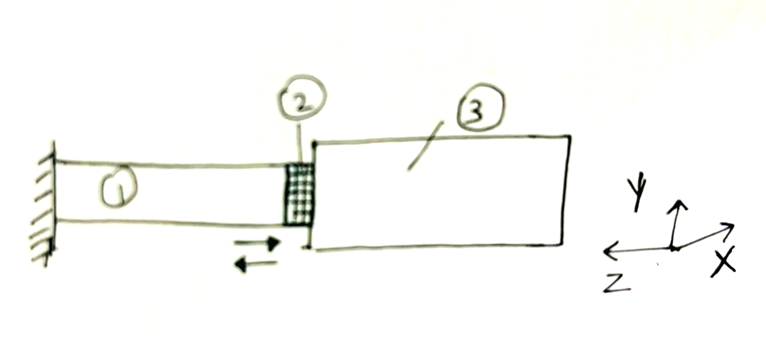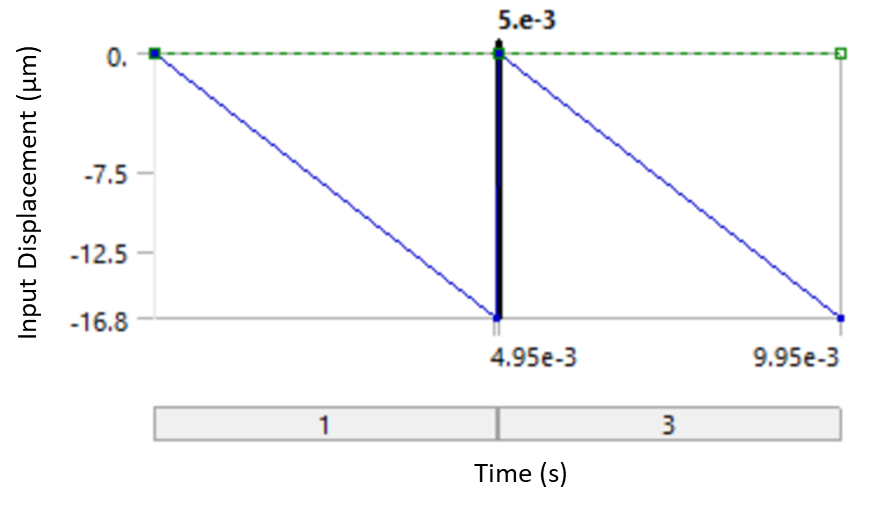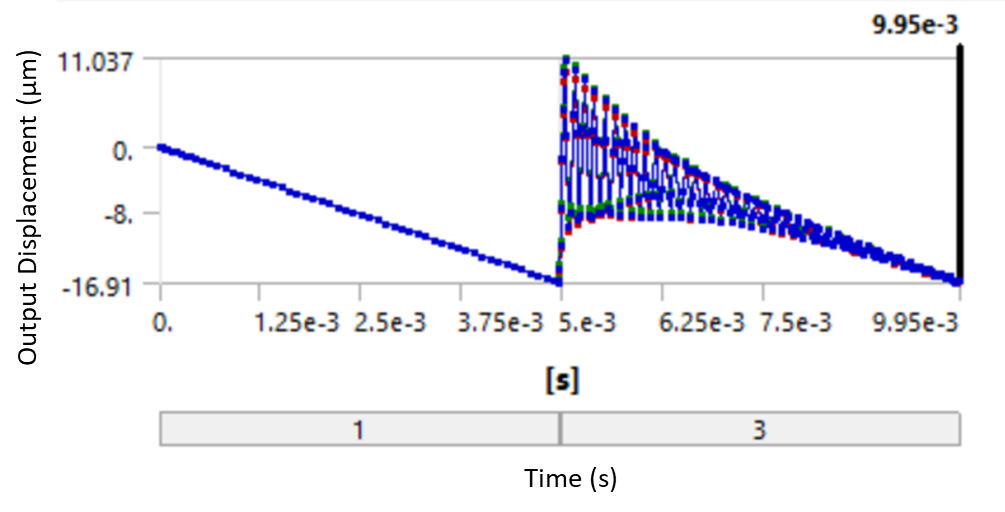-
-
January 5, 2024 at 9:21 am
Pranshu Kharbanda
SubscriberDear all,
I am performing transient simulation on the system shown below. Here, item 1 and 3 are glue together with adhesive. So, i have applied bonded contact with MPC formulation between item 1 and 2, and between item 2 and 3. All the items are modeled as linear elastic materials (Young modulus item 1: 44 GPa, item 2: 2 GPa, item 3: 193 GPa). One of the input boundary conditions is a displacement controlled loading (represented by arrow in Z direction) and shown below (right image). I can vary the frequency, by changing the time for one cycle. Currently it represents 200 Hz (1/.005s).
I expected to see similar displacement output for Item 3, however there is a high rippling effect as I have shown in the deformation plot below. This didn't occur at lower frequency for instance 100 Hz. Could anyone advise how to rectify this? Thank you.
-
January 5, 2024 at 10:18 am
ErKo
Ansys EmployeeHi
This could be a resonance (e.g., axial mode) excited as you move the part very fast back to zero – not sure why you do not see it so much at 100 Hz.
If you do not care about such dynamic effects (e.g., resonance), then run quasi-static by setting time integtaion to OFF (this can be done under analysis settings).
What are you trying to model/analyse here? So describe the goal of your analysis, and what results do you want to study?
All the best
Erik
-
January 6, 2024 at 5:41 pm
Pranshu Kharbanda
SubscriberHi Erik,
Thanks for your time to look into,
I had checked the resonant modes of this system, wherein the first mode was around 2300 Hz..if this is what you meant by resonance excited.
As I understand frorm Ansys documentation that time dependent loads can only be simulated in transient or explicit. quasi static would also ignore the inertia effects.
Overall here trying to analyse stresses in adhesive layer, as expect high stress due to sudden drop in displacement at higher frequencies (similar to short impulse).fyi, Item 1 here is supplying energy (in form of displacement) to item 3.
-
January 9, 2024 at 2:28 am
Pranshu Kharbanda
Subscriber@Erik , kindly let me know if you may need any additional details here
Thanks :)
-
-
-
January 11, 2024 at 10:14 am
Pranshu Kharbanda
SubscriberHi,
I tried to add damping for adhesive material and i see two effects based on if i apply alpha or beta damping factors
Firstly, with alpha factor (0.5), there isn't much reduction in the observed rippling effect or stress in adhesive layer.
However, with beta factor( 1e-4, which is a very low value), there is no rippling but the stress in adhesive layer changes significantly from 45 Mpa to 0.9 Mpa.
I am not much familiar with damping controls in ansys. would you have some insights so as for this observation. I did not expect the stress value to change with application of damping
-
January 11, 2024 at 11:40 am
ErKo
Ansys EmployeeHi
See our dynamics courses for more info on damping (which a user input which you need to measure or know):
/courses/index.php/courses/intro-to-modal-based-methods/lessons/summary-28/#:~:text=Beta%20damping%20provides%20a%20damping,done%20via%20%E2%80%9CAnalysis%20Settings%E2%80%9D.
/courses/wp-content/uploads/sites/2/2020/12/2.6.2-Fundamentals-of-Damping-New-Template.pdf
https://www.youtube.com/watch?v=ymTUmSQsyWo
/forum/forums/topic/damping-in-transient-structural-fea-analysis/
Search the internet for more info on this.
All the best
Erik
-
January 12, 2024 at 10:10 am
Pranshu Kharbanda
SubscriberHi Erik, Thank you for the links .
I have had already read those, however still not completely understand how ansys software is integrating beta damping in the analysis. Since the results are almost unaffected with constant material or alpha damping compared to beta damping.
Nonetheless i shall look for more information on the internet.
Thanks.
-
- The topic ‘Stress Analysis at 200 Hz’ is closed to new replies.



-
4618
-
1530
-
1386
-
1210
-
1021

© 2025 Copyright ANSYS, Inc. All rights reserved.










